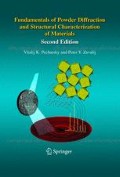Conventional crystallography was developed using the explicit assumption that crystalline objects maintain ideal periodicity in three dimensions. As a result, any ideal three-dimensional crystal structure can be described using a periodic lattice and one of the 230 crystallographic space groups (see Sect. 3.4). The overwhelming majority of both naturally occurring and synthetic crystalline solids are indeed nearly ideally periodic. Their diffraction patterns are perfectly periodic since Bragg peaks are only observed at the corresponding points of the reciprocal lattice, which reflects both the symmetry and three-dimensional periodicity of the crystal lattice. Long ago, the first aperiodic crystal was reported,1 and the apparent absence of the three-dimensional periodicity of diffraction patterns was later found in a number of materials. One of the most prominent examples is the 1984 discovery of the fivefold symmetry in the diffraction pattern of rapidly cooled Al0.86Mn0.14 alloy.2 Supported by many experimental observations, several approaches to describe the symmetry of aperiodic structures have been developed and successfully used to establish the crystal structure of these unusual materials.
Probably the most fruitful method has been suggested by P.M. de Wolff3 in which more than three physical dimensions are used to represent the crystal lattice and thus to restore its periodicity in the so-called superspace. Then the resulting aperiodic diffraction pattern is simply a projection of the crystal lattice, which is periodic in the superspace, upon the physical space, which is three-dimensional. The diffraction pattern of an aperiodic crystal usually contains a subset of strong (i.e., highly intense) diffraction peaks, which are called main peaks, and their indices are described using three integers corresponding to a standard three-dimensionally periodic crystal lattice. The subsets of the so-called satellite peaks are weaker, and their indices include more than three integers to reflect the increased dimensionality of the superspace (see the footnote on page 409).
Access this chapter
Tax calculation will be finalised at checkout
Purchases are for personal use only
Preview
Unable to display preview. Download preview PDF.
5.6 Additional Reading
C. Janot, Quasicrystals. A primer, Clarendon Press, Oxford (1992).
International Tables for Crystallography, vol. A, Fifth Revised Edition, Theo Hahn, Ed., Published for the International Union of Crystallography by Springer, Berlin (2002).
T. Janssen, G. Chapuis, M. de Boissieu, Aperiodic crystals: from modulated phases to qua-sicrystals. Oxford University Press, Oxford (2007).
A. Yamamoto, Crystallography of quasiperiodic crystals, Acta Cryst. A52, 509 (1996).
M. Dusšek, V. Petříček, M. Wunschel, R.E. Dinnebier, S. van Smaalen, Refinement of modulated structures against X-ray powder diffraction data with JANA2000. J. Appl. Cryst. 34, 398 (2001).
A.V. Mironov, A.M. Abakumov, E.V. Antipov, Powder diffraction of modulated and composite structures. Rigaku J. 19–20, 23 (2003).
Rights and permissions
Copyright information
© 2009 Springer-Verlag Berlin Heidelberg
About this chapter
Cite this chapter
(2009). Nonconventional Symmetry. In: Fundamentals of Powder Diffraction and Structural Characterization of Materials. Springer, Boston, MA. https://doi.org/10.1007/978-0-387-09579-0_5
Download citation
DOI: https://doi.org/10.1007/978-0-387-09579-0_5
Publisher Name: Springer, Boston, MA
Print ISBN: 978-0-387-09578-3
Online ISBN: 978-0-387-09579-0
eBook Packages: Chemistry and Materials ScienceChemistry and Material Science (R0)

